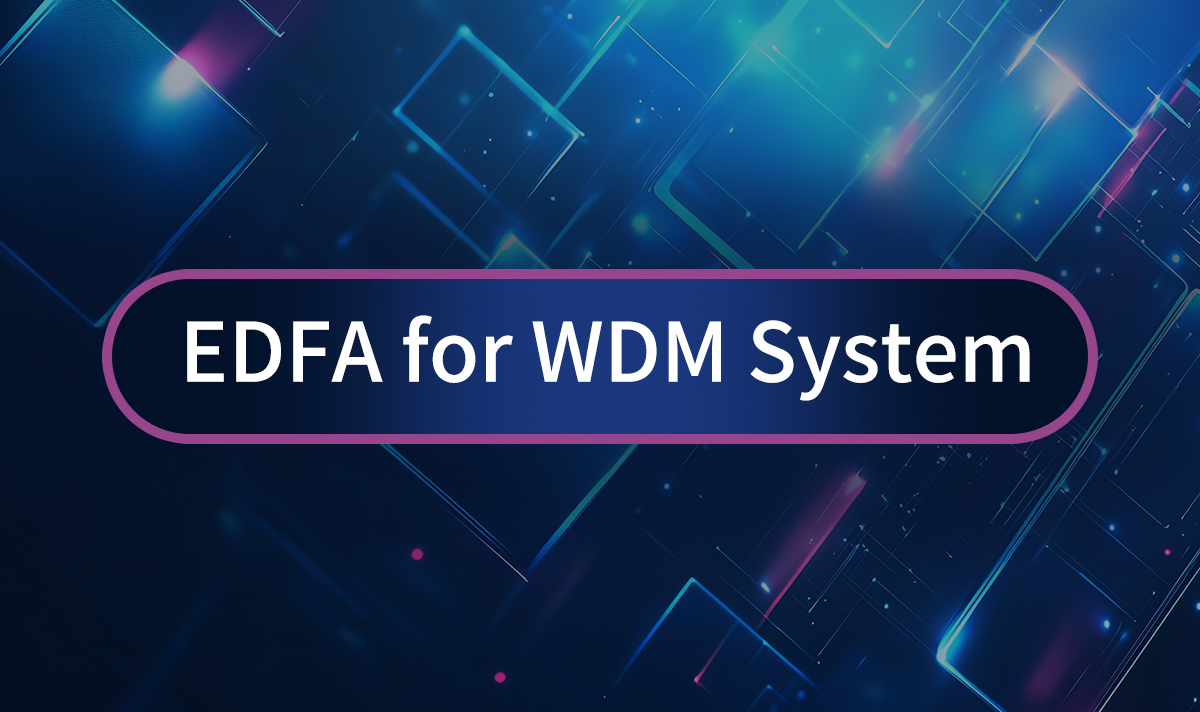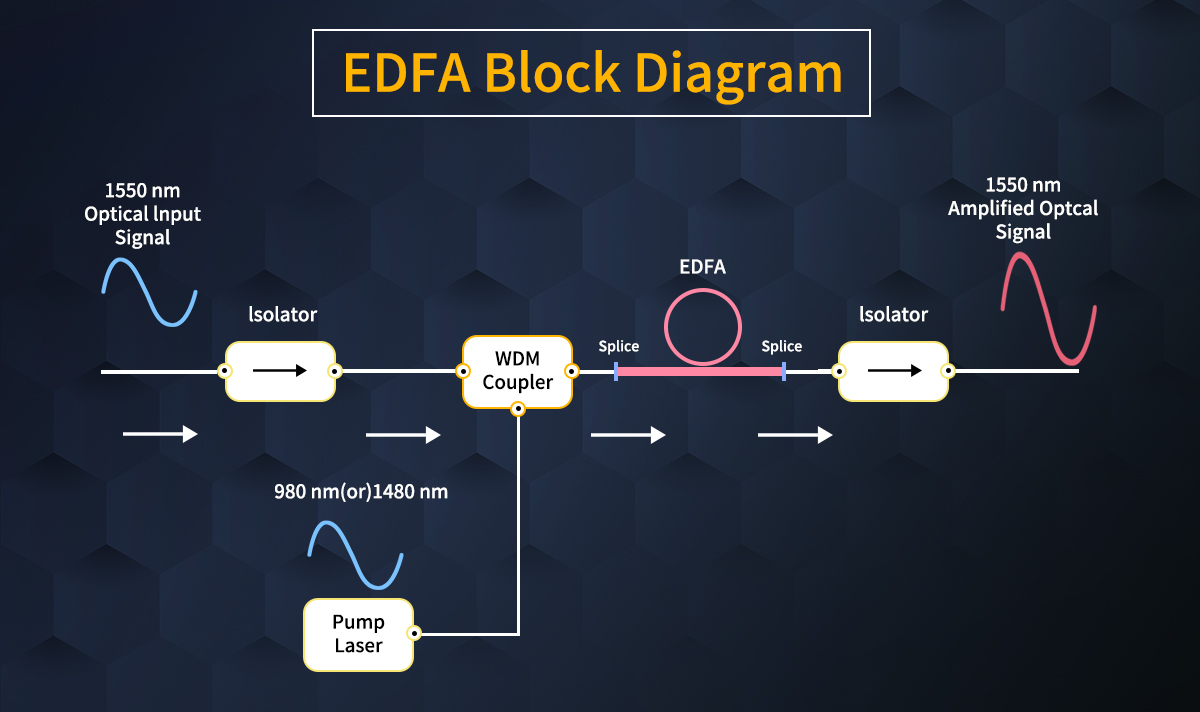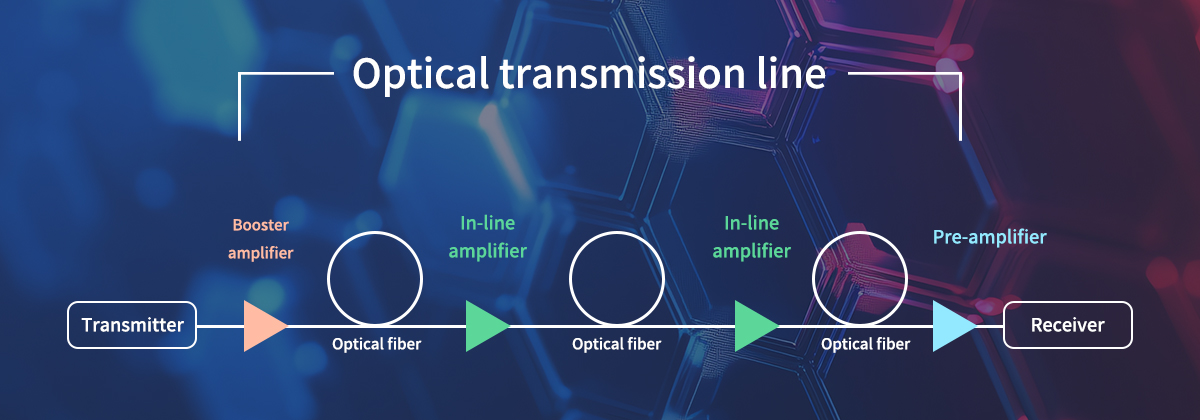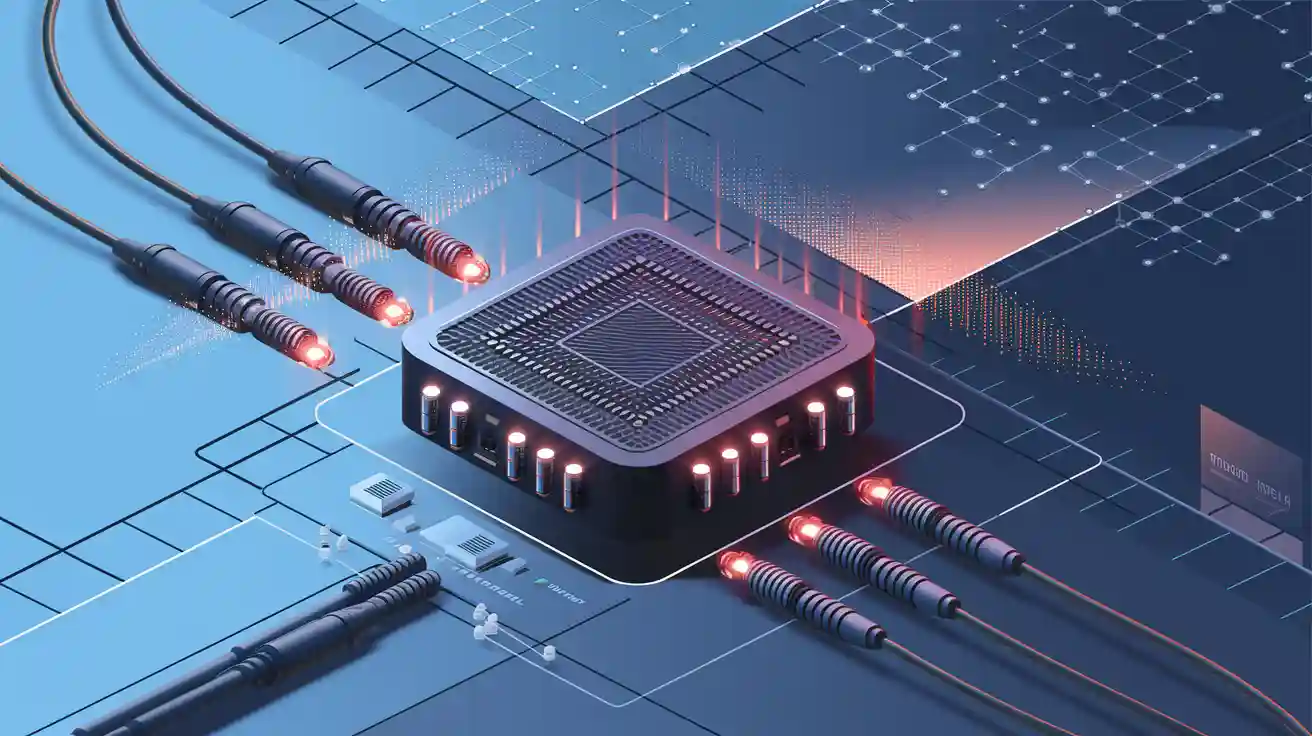
An erbium-doped fiber amplifier (EDFA) is a type of optical amplifier that increases the strength of light signals traveling through fiber optic cables. It uses a special fiber infused with erbium ions to boost signal power without converting light into electrical signals. You rely on EDFAs in optical networks to maintain signal quality during long distance communication. These amplifiers ensure that weak signals regain their strength, enabling data to travel farther and faster.
In modern fiber optic communication systems, EDFAs play a critical role. They allow high-speed data transmission over vast distances, supporting internet connectivity, video streaming, and cloud services. Their efficiency and reliability make them indispensable for global communication infrastructure.
Key Takeaways
Erbium-doped fiber amplifiers (EDFAs) make weak light signals stronger.
This helps data move farther and faster in fiber optic cables.
EDFA technology is important for fast internet, video streaming, and cloud use.
Key parts of an EDFA are erbium-doped fiber, a pump laser, and a WDM.
These parts work together to make signals stronger and more efficient.
EDFAs work best at 1550 nm, where optical fibers lose less signal.
Future EDFAs may include broadband amplifiers and quantum communication systems.
These changes could make data faster and safer to send.
How Does an Erbium-Doped Fiber Amplifier Work?
An erbium-doped fiber amplifier (EDFA) operates by amplifying optical signals through a process called stimulated emission. You’ll find that this mechanism relies on erbium ions embedded in the fiber to boost the strength of light signals. When optical signals pass through the erbium-doped fiber, the ions interact with the incoming light, increasing its intensity without converting it into electrical signals.
The amplification process begins with a pump laser. This laser injects energy into the erbium-doped fiber, exciting the erbium ions to higher energy states. As the optical signals travel through the fiber, the excited ions release their stored energy in the form of amplified light. This process ensures that weak signals regain their strength, enabling long-distance communication with minimal loss.
Several components work together to make this mechanism efficient. The erbium-doped fiber serves as the medium for amplification. Pump lasers provide the necessary energy, while wavelength division multiplexers (WDMs) combine the pump light and optical signals. These components ensure high amplification efficiency and low noise, making EDFAs ideal for optical networks.
📌 Did you know? Experimental data shows that EDFAs can achieve a gain of up to 51 dB with a noise figure as low as 3.1 dB, demonstrating their remarkable efficiency in optical amplification.

Pumping: A high-power laser "pump" (typically at 980nm or 1480nm wavelength) excites the Erbium ions within the doped fiber to a higher energy state.
Signal Input: The weak optical data signal (in the C-band: 1530-1565nm or L-band: 1565-1625nm) enters the doped fiber.
Stimulated Emission: When photons from the data signal interact with the excited Erbium ions, they trigger those ions to drop to a lower energy state. Crucially, this drop releases new photons that are identical to the incoming signal photons in wavelength, phase, and direction. This is stimulated emission.
Amplified Output: This process cascades, resulting in a significantly boosted output signal carrying the original data, all within the optical domain – no conversion to electricity needed.
Components of an Erbium-Doped Fiber Amplifier
Erbium-Doped Fiber: The core component containing erbium ions that amplify incoming optical signals (especially around 1550nm) via stimulated emission. Designed for efficient energy transfer, it's ideal for long-distance communication. Precise gain control (e.g., via 8-channel all-optical feedback loops) enhances stability and reduces noise.
Pump Laser: Provides energy to excite erbium ions. 980nm lasers are preferred over 1480nm due to lower noise and thermal demands. High reliability is demonstrated for 980nm lasers: 110 FIT rate (60% confidence, improved from 180 FIT) and MTTF exceeding 2 million hours, supporting long amplifier lifespan.
WDM (Wavelength Division Multiplexer): Combines pump light with optical signals efficiently while maintaining integrity. Critical parameters include a Minimum Differential Mode Gain of 0.14 dB, Overall DMG of 1.59dB, and OSNR of 13.89dB after 8-stage transmission. It enables feasible 1000km transmission for 100Gb/s DP-QPSK signals. Tip: Select WDMs with high DMG and low noise for optimal performance.
Advantages of EDFA in Optical Networks
EDFAs became the dominant optical amplifier technology due to several key advantages perfectly suited for optical transceiver communication bands:
High Gain: Provide substantial signal boost (typically 15-40 dB).
Low Noise Figure: Minimize the degradation of the signal-to-noise ratio (SNR), crucial for long-haul transmission. This is vital for maintaining signal integrity far beyond the reach of a single optical transceiver.
Wavelength Transparency: Amplify multiple wavelengths simultaneously within their operating band (C-band primarily, L-band increasingly), making them ideal for Dense Wavelength Division Multiplexing (DWDM) systems where numerous optical transceiver channels coexist.
Immunity to Crosstalk: Exhibit minimal interference between different wavelength channels.
High Output Power: Capable of launching strong signals back into the fiber.
All-Optical Operation: Avoid electronic bottlenecks and power consumption associated with O-E-O conversion.
Key EDFA Parameters and Specifications

Selecting the right EDFA amplifier requires understanding its specifications. Performance varies significantly based on application:
EDFA Parameter | Booster Amplifier | In-Line Amplifier | Pre-Amplifier | Key Impact |
|---|---|---|---|---|
Primary Role | Launch high power into fiber | Compensate span loss | Boost weak Rx signal | Determines placement & critical specs |
Gain | Medium (15-25 dB) | High (20-35 dB) | Very High (30-40+ dB) | Determines signal boost level |
Output Power | Very High (17-23 dBm+) | High (10-18 dBm) | Medium (10-15 dBm) | Dictates launch power & reach; critical for long-haul optical networks |
Noise Figure (NF) | Medium (5-7 dB) | Low (4-6 dB) | Ultra-Low (3-5 dB) | Critical for signal quality; lower NF = better Rx sensitivity for optical transceiver |
Key Application | Tx side after laser source | Mid-span in long links | Rx side before detector | Optimizes link budget for high-speed optical transceiver performance |
Applications of EDFA in Optical Networks
EDFA technology underpins virtually all long-distance and high-capacity optical communication:
Long-Haul & Submarine Transmission: Essential for spanning thousands of kilometers under oceans and continents without costly regeneration sites. EDFA for long-haul transmission is non-negotiable.
Metro & Regional Networks: Connecting cities and data centers over hundreds of kilometers, enabling robust optical network infrastructure.
Dense Wavelength Division Multiplexing (DWDM): The heart of DWDM systems, amplifying dozens or hundreds of channels simultaneously, maximizing fiber capacity and supporting diverse optical transceiver types.
Cable Television (CATV): Distributing analog or digital RF video signals over fiber optic networks.
Fiber-to-the-Home (FTTH) Backbone: Amplifying signals for distribution in large passive optical networks (PONs).
The growing demand for high-speed communication highlights the importance of EDFAs in shaping the future of optical networks. Their ability to boost signals directly supports the scalability and reliability of modern telecommunication systems.
Future Trends in EDFA Technology
While EDFAs are mature, evolution continues:
Gain Flattening: Improved techniques for uniform amplification across the entire C and L bands.
Higher Power & Lower Noise: Ongoing development for pushing distances and channel counts.
Integration: Combining EDFA functions with other elements like DCMs (Dispersion Compensation Modules) or WSS (Wavelength Selective Switches) into compact optical network units.
L-band Expansion: Meeting the demand for even greater capacity beyond the C-band. LINK-PP EDFA solutions are actively innovating in this space.
FAQ
What is the primary purpose of an EDFA?
An EDFA amplifies weak optical signals in fiber optic networks. It boosts signal strength without converting light into electrical signals, ensuring long-distance data transmission with minimal loss.
What makes EDFAs different from other optical amplifiers?
EDFAs use erbium-doped fibers to amplify signals in the 1550nm wavelength range. This range aligns with the low-loss window of optical fibers, making EDFAs highly efficient for telecommunications.
What are the key components of an EDFA?
An EDFA consists of three main components:
Erbium-doped fiber: Amplifies the signal.
Pump laser: Provides energy for amplification.
Wavelength division multiplexer (WDM): Combines pump light and optical signals.
What are the limitations of EDFAs?
EDFAs have a limited gain bandwidth and cannot amplify visible light signals. Their performance also depends on precise pump laser control, which can be sensitive to wavelength variations.
What industries benefit most from EDFAs?
Telecommunications, cloud computing, and internet service providers rely heavily on EDFAs. These amplifiers support long-haul communication, dense wavelength division multiplexing (DWDM), and high-speed data transmission.
💡 Tip: If you're exploring optical networks, understanding EDFAs can help you optimize signal amplification and network performance.
See Also
Exploring Wavelength Division Multiplexing and Its Uses
The Importance of Digital Monitoring in Optical Transceivers


